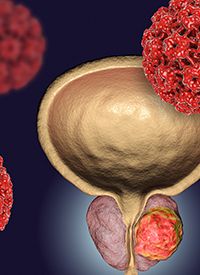Article
Olaparib Approved in China for BRCA+ Metastatic Castration-Resistant Prostate Cancer
Author(s):
The Chinese National Medical Products Administration has granted conditional approval to olaparib for use as a monotherapy in the treatment in adult patients with germline or somatic BRCA-mutated, metastatic castration-resistant prostate cancer who have progressed after previous treatment that included a new hormonal agent like abiraterone acetate or enzalutamide.

The Chinese National Medical Products Administration has granted conditional approval to olaparib (Lynparza) for use as a monotherapy in the treatment in adult patients with germline or somatic BRCA-mutated, metastatic castration-resistant prostate cancer (CRPC) who have progressed after previous treatment that included a new hormonal agent like abiraterone acetate (Zytiga) or enzalutamide (Xtandi).1
The regulatory decision was supported by data from a subgroup analysis of the phase 3 PROfound trial (NCT02987543), which demonstrated that the PARP inhibitor significantly improved radiographic progression-free survival (rPFS) and overall survival (OS) vs abiraterone or enzalutamide in this patient population.
Specifically, olaparib resulted in a 78% reduction in the risk of disease progression or death compared with the hormonal agents (HR, 0.22; 95% CI, 0.15-0.32; P <.0001). The rPFS reported in the investigative and control arms was 9.8 months and 3.0 months, respectively. The PARP inhibitor also reduced the risk of death by 37% in this patient population (HR, 0.63; 95% CI, 0.42-0.95). The median OS was 20.1 months in the investigative arm vs 14.4 months in the control arm.
Continued approval of the agent in this indication will be contingent on verification and description of clinical benefit in a planned bridging trial that we be performed in Chinese patients, according to a press release issued by AstraZeneca and Merck.
“[Olaparib] more than tripled rPFS and is the only PARP inhibitor to show an OS benefit compared with treatment with abiraterone or enzalutamide for men with BRCA-mutated metastatic CRPC,” Dave Frederickson, executive vice president of the oncology business unit at AstraZeneca, stated in a press release.
In the prospective, biomarker-selected, phase 3 PROfound trial, investigators examined the safety and efficacy of olaparib in patients with metastatic CRPC who had disease progression while receiving a new hormonal agent.2
To be eligible for enrollment, patients needed to be at least 18 years of age, have confirmed metastatic CRPC and disease progression during treatment with abiraterone or enzalutamide, and acceptable organ and bone marrow function. Notably, patients were permitted to have received prior taxane therapy. Patients without prior surgical castration were required to continue to receive luteinizing hormone-releasing hormone analogue therapy.
Patients were enrolled to 1 of 2 cohorts depending on their qualifying gene alteration. Cohort A enrolled patients with at least 1 alteration in BRCA1, BRCA2, or ATM. Patients were included on cohort B of the trial if they had tumors that harbored alterations in any of the following genes: BRIP1, BARD1, CDK12, CHEK1, CHEK2, FANCL, PALB2, PPP2R2A, RAD51B, RAD51D, and RAD54L.
Participants were randomized 2:1 to receive olaparib at a twice-daily dose of 300 mg or the prespecified physician’s choice of enzalutamide at a once-daily dose of 160 mg or abiraterone at a once-daily dose of 1000 mg plus prednisone at a twice-daily dose of 5 mg. Patients were stratified based on prior taxane use (yes vs no) and measurable disease (yes vs no).
The primary end point of the trial was PFS per independent review committee assessment in patients with at least 1 alteration in BRCA1, BRCA2, or ATM (cohort A). Important secondary end points included confirmed objective response rate (ORR), time to pain progression, OS, and circulating tumor cell conversion rate.
In cohort A, 162 patients received olaparib and 83 patients received hormonal therapy. Baseline characteristics were noted to be well balanced between the treatment arms. However, a higher percentage of patients who had visceral metastases and a higher median baseline prostate-specific antigen concentration were randomized to the control arm. More patients whose tumors harbored an ATM alteration were randomized to receive olaparib.
Earlier data published in the New England Journal of Medicine showed that olaparib elicited a confirmed ORR of 33% (n = 28/84) vs 2% (n = 1/43) with hormonal therapy (odds ratio, 20.86; 95% CI, 4.18-379.18; P <.001). The median time to pain progression was noted to be significantly longer in the investigative arm vs the control arm (HR, 0.44; 95% CI, 0.22-0.91; P = .02).
Regarding safety, the most frequent adverse effects of any grade reported with olaparib included anemia, nausea, and fatigue or asthenia; with the control treatment, these toxicities included fatigue or asthenia.
References
- LYNPARZA (olaparib) approved in China for the treatment of certain patients with BRCA-mutated metastatic castration-resistant prostate cancer. News release. Merck. June 24, 2021. Accessed June 24, 2021. https://bit.ly/3h0OIck
- de Bono J, Mateo J, Fizazi, K, et al. Olaparib for metastatic castration-resistant prostate cancer. N Engl J Med. 2020;382(22):2091-2102. doi:10.1056/NEJMoa1911440









